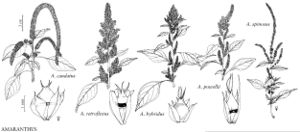Amaranthus retroflexus
Sp. Pl. 2: 991. 1753.
Plants densely to moderately pubescent, especially distal parts of stem and branches. Stems erect, reddish near base, branched in distal part to simple 0.2–1.5(–2) m; underdeveloped or damaged plants rarely ascending to nearly prostrate. Leaves: petiole 1/2 to equaling blade; blade ovate to rhombic-ovate, 2–15 × 1–7 cm, base cuneate to rounded-cuneate, margins entire, plane or slightly undulate, apex acute, obtuse, or slightly emarginate, with terminal mucro. Inflorescences terminal and axillary, erect or reflexed at tip, green or silvery green, often with reddish or yellowish tint, branched, leafless at least distally, usually short and thick. Bracts lanceolate to subulate, (2.5–)3.5–5(–6) mm, exceeding tepals, apex acuminate with excurrent midrib. Pistillate flowers: tepals 5, spatulate-obovate, lanceolate-spatulate, not clawed, subequal or unequal, (2–)2.5–3.5(–4) mm, membranaceous, apex emarginate or obtuse, with mucro; style branches erect or slightly spreading,; stigmas 3. Staminate flowers few at tips of inflorescences; tepals 5; stamens (3–)4–5. Utricles broadly obovoid to broadly elliptic, 1.5–2.5 mm, shorter than or subequal to tepals, smooth or slightly rugose, especially near base and in distal part, dehiscence regularly circumscissile. Seeds black to dark reddish brown, lenticular to subglobose-lenticular, 1–1.3 mm, smooth, shiny.
Phenology: Flowering summer–fall.
Habitat: Banks of rivers, lakes, and streams, disturbed habitats, agricultural fields, railroads, roadsides, waste areas
Elevation: 0-2500 m
Distribution
St. Pierre and Miquelon, Alta., B.C., Man., N.B., Nfld. and Labr., N.W.T., N.S., Nunavut, Ont., P.E.I., Que., Sask., Ala., Alaska, Ariz., Ark., Calif., Colo., Conn., Del., D.C., Fla., Ga., Idaho, Ill., Ind., Iowa, Kans., Ky., La., Maine, Md., Mass., Mich., Minn., Miss., Mo., Mont., Nebr., Nev., N.H., N.J., N.Mex., N.Y., N.C., N.Dak., Ohio, Okla., Oreg., Pa., R.I., S.C., S.Dak., Tenn., Tex., Utah, Vt., Va., Wash., W.Va., Wis., Wyo., introduced and naturalized nearly worldwide.
Discussion
Amaranthus retroflexus, native to central and eastern North America, is a successful invasive species and has effectively colonized a wide range of habitats on all inhabited continents. Its variability is extremely wide; usually the species is easily recognized and its identification causes no specific problems. Infraspecific entities described within A. retroflexus are mostly ecologic variants of little or no taxonomic value. Two varieties are more easily recognized: the common var. retroflexus, with bracts about 1.5–2 times as long as tepals, and a more rare var. delilei (Richter & Loret) Thellung (= A. delilei Richter & Loret), with bracts 1–1.5 times as long as tepals.
Occasional forms morphologically intermediate between Amaranthus retroflexus and taxa of the A. hybridus aggregate (e.g., A. powellii and A. hybridus, in the strict sense) are known both in the Americas and the Old World. Usually such plants are treated as hybrids; in many cases they are probably just extremes of the natural variability of A. retroflexus. Putative hybrids of A. retroflexus were described from Europe as A. ×ozanonii Thellung (A. hybridus × A. retroflexus) and A. ×soproniensis Priszter & Karpáti (A. powellii × A. retroflexus) (see A. Thellung 1914–1919; S. Priszter 1958; P. Aellen 1959; F. Grüll and S. Priszter 1973).
Selected References
None.
